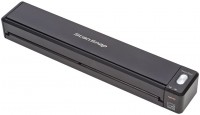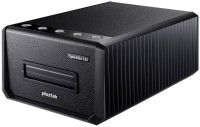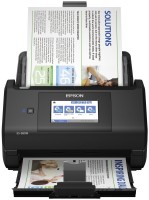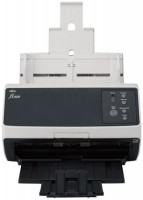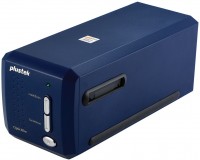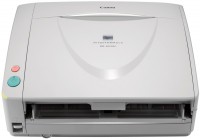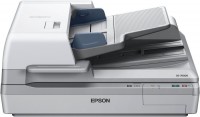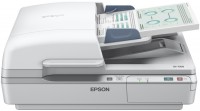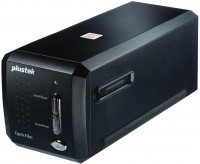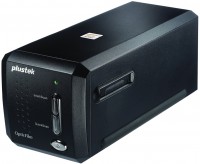Scanners Epson
All Scanners Advanced filters → |
You might be interested in
Scanners: specifications, types
Product type
— Tablet. In such scanners, the material to be scanned is placed over a special glass surface, under which a photo sensor moves; the original itself does not move. Flatbed models are the most "omnivorous": they have no restrictions on the thickness of the scanned material and usually allow you to work not only with individual sheets, but also with pages and covers of books and magazines, product labels, etc. Their disadvantage is their significant dimensions — the working surface of the scanner must be no smaller than the supported format (see "Format").
— Lengthy. In pull- through scanners, the photo sensor is stationary, and the scanned material moves relative to it using the feed mechanism. They are much more compact than tablet counterparts (see above), because. of the requirements for the dimensions of the scanner in this case, in fact, only the width remains. Such scanners make it much easier to process long materials; in addition, they are often equipped with automatic document feeders(see below for more details), which makes it much easier to work with a large amount of materials. On the other hand, the feed mechanism can only work with single sheets and will not cope with books and other bulky media.
— Tablet / lingering. The most versatile models that combine the advantages of both designs. They have both an open...ing lid with a glass surface below it, which allows you to work with bulky media (like flatbed models), and a transport mechanism that makes it easier to work with long originals and single sheets (like in broaching designs). They are equipped with two optical sensors and in some cases you can even use both at the same time. The disadvantages of such scanners are significant cost and dimensions, and therefore they are usually used in the professional field, where you often have to scan large volumes of dissimilar materials.
— Slide scanner. These scanners differ from all previous types due to the peculiarities of the processed originals — they are designed to work with transparent materials (slides), such as photographic film. Other scanners equipped with slide modules (see "Slide module") can work with slides, but it is specialized models that provide the best quality.
— Manual. The name of this type is due to the fact that such a scanner must be manually moved over the scanned surface during operation. This is not as convenient as using flatbed or broaching models (see above), especially when working with a large amount of materials. At the same time, the dimensions of hand-held scanners are even smaller than those of broaching ones, while they do not have such a drawback as a limitation on the thickness of the processed materials. Such a device can "take" an image even from a large object that cannot be placed in a flatbed scanner — for example, a box.
— Lengthy. In pull- through scanners, the photo sensor is stationary, and the scanned material moves relative to it using the feed mechanism. They are much more compact than tablet counterparts (see above), because. of the requirements for the dimensions of the scanner in this case, in fact, only the width remains. Such scanners make it much easier to process long materials; in addition, they are often equipped with automatic document feeders(see below for more details), which makes it much easier to work with a large amount of materials. On the other hand, the feed mechanism can only work with single sheets and will not cope with books and other bulky media.
— Tablet / lingering. The most versatile models that combine the advantages of both designs. They have both an open...ing lid with a glass surface below it, which allows you to work with bulky media (like flatbed models), and a transport mechanism that makes it easier to work with long originals and single sheets (like in broaching designs). They are equipped with two optical sensors and in some cases you can even use both at the same time. The disadvantages of such scanners are significant cost and dimensions, and therefore they are usually used in the professional field, where you often have to scan large volumes of dissimilar materials.
— Slide scanner. These scanners differ from all previous types due to the peculiarities of the processed originals — they are designed to work with transparent materials (slides), such as photographic film. Other scanners equipped with slide modules (see "Slide module") can work with slides, but it is specialized models that provide the best quality.
— Manual. The name of this type is due to the fact that such a scanner must be manually moved over the scanned surface during operation. This is not as convenient as using flatbed or broaching models (see above), especially when working with a large amount of materials. At the same time, the dimensions of hand-held scanners are even smaller than those of broaching ones, while they do not have such a drawback as a limitation on the thickness of the processed materials. Such a device can "take" an image even from a large object that cannot be placed in a flatbed scanner — for example, a box.
Portable
Small size scanners designed for maximum portability. Usually they are cylindrical or rectangular devices with a through slot through which the scanned document is passed during operation; thus, the size of such a scanner is much smaller than that of a traditional scanner, in which the entire document must be placed. Portable scanners tend to be of low resolution and are intended primarily for light tasks such as scanning text documents. They are well suited for use with laptops — in particular, the dimensions allow them to be transported in the same bag with a laptop computer.
Format
— A0. The largest sheet size specified by the ISO 216 standard is 1189x841 mm (4 times the size of a newspaper spread). It is found exclusively in broaching-type devices (see above), belonging to the professional class.
— A1. Sheet size 594x841 mm. For a number of reasons, this option has not received much distribution in scanners.
— A3. Sheet size 297x420 mm, i.e. 2 times larger than the standard landscape. Support for this format allows you to scan quite large materials, such as an entire spread of a magazine or a page of a newspaper, in one pass.
— A4. Standard landscape sheet 210x297 mm, the most common paper format today, especially in office documentation. Most scanners have this format, it is enough for most personal and work tasks.
— A5. 148x210 mm, in other words — half of a standard landscape sheet. Scanners for this format are compact, but they are very rare, because. working with the popular A4 format on them is at least inconvenient.
— A6. 105x148 mm, a quarter of a standard landscape sheet. Such scanners are small in size and are convenient for working with photographs, where the standard print size (10x15 cm) is approximately equal to A6, but today they are almost never used for the same reasons as A5 (see...above).
Specifies the maximum size allowed for scanning. Note that the actual size of the maximum scan area (see below) may be larger than the paper size specified in the specifications. And in broaching models (see "Type") the size of the processed materials is generally limited only by the width of the scanner. In fact, manufacturers indicate the maximum size in order to make it easier for the user to determine the capabilities of the scanner and its compatibility with popular paper sizes.
— A1. Sheet size 594x841 mm. For a number of reasons, this option has not received much distribution in scanners.
— A3. Sheet size 297x420 mm, i.e. 2 times larger than the standard landscape. Support for this format allows you to scan quite large materials, such as an entire spread of a magazine or a page of a newspaper, in one pass.
— A4. Standard landscape sheet 210x297 mm, the most common paper format today, especially in office documentation. Most scanners have this format, it is enough for most personal and work tasks.
— A5. 148x210 mm, in other words — half of a standard landscape sheet. Scanners for this format are compact, but they are very rare, because. working with the popular A4 format on them is at least inconvenient.
— A6. 105x148 mm, a quarter of a standard landscape sheet. Such scanners are small in size and are convenient for working with photographs, where the standard print size (10x15 cm) is approximately equal to A6, but today they are almost never used for the same reasons as A5 (see...above).
Specifies the maximum size allowed for scanning. Note that the actual size of the maximum scan area (see below) may be larger than the paper size specified in the specifications. And in broaching models (see "Type") the size of the processed materials is generally limited only by the width of the scanner. In fact, manufacturers indicate the maximum size in order to make it easier for the user to determine the capabilities of the scanner and its compatibility with popular paper sizes.
Max. resolution
The highest resolution of the digital image generated by the scanner during operation. Specified in dots per inch — dpi (dots per inch).
The higher the scan resolution, the higher the resolution of the resulting image will be (with the same size of the source material) and the more accurately small details will be transmitted on it. On the other hand, high resolution noticeably affects the price of the scanner, increases the processing time and the size of the resulting file — despite the fact that the real need for high detail is not always present, and in some cases it is even unnecessary (for example, when processing an image with small artifacts, not visible at low detail). Therefore, when choosing by this parameter, you should not chase high resolution values — you should proceed from the real need and the specifics of the intended use of the scanner.
The simplest modern scanners have a resolution of about 300x300 dpi — this is quite enough for text recognition with an average font size. And in high-end professional models, this figure can exceed 7000x7000 dpi.
The higher the scan resolution, the higher the resolution of the resulting image will be (with the same size of the source material) and the more accurately small details will be transmitted on it. On the other hand, high resolution noticeably affects the price of the scanner, increases the processing time and the size of the resulting file — despite the fact that the real need for high detail is not always present, and in some cases it is even unnecessary (for example, when processing an image with small artifacts, not visible at low detail). Therefore, when choosing by this parameter, you should not chase high resolution values — you should proceed from the real need and the specifics of the intended use of the scanner.
The simplest modern scanners have a resolution of about 300x300 dpi — this is quite enough for text recognition with an average font size. And in high-end professional models, this figure can exceed 7000x7000 dpi.
Optical element
— CIS, abbreviation for "Contact Image Sensor" — contact image sensor. The simplest type of optical element: it is a line across the entire width of the scanner's working space, on which photocells that read the image and LEDs that provide illumination are located in a row. They are inexpensive and take up little space, which, accordingly, makes the scanners themselves cheaper and smaller. On the other hand, CIS sensors have a shallow depth of field, and even small bumps in the scanned image can be out of focus. However, in general, they are quite suitable for both personal and not too complex professional tasks.
— CCD, short for "Charge-Coupled Device" — a charge-coupled device. A much more complex design than CIS, includes a fluorescent lamp, lens and mirror. CCD scanners are larger, heavier and much more expensive than their counterparts in CIS. On the other hand, this type of optical element provides high-quality colour reproduction and a good depth of field, coping well with complex-shaped media. Therefore, advanced professional scanners are usually equipped with a CCD.
— CMOS. The abbreviation for "Complementary Metal-Oxide-Semiconductor" is a complementary metal-oxide-semiconductor structure (the designation CMOS is also used in Russian). A key feature of CMOS sensors is that they capture the scanned image as a whole, similar to photography (and not...line by line, as in other types of optical elements). In fairness, it should be noted that the "instantaneous" scanning does not give a tangible advantage in speed, because. processing the captured image takes quite a long time. However, this feature is extremely useful in cases where it is difficult to ensure the immobility of the scanned material and/or uniform movement of the optical element relative to this material. Such situations often arise when working with book and handheld scanners (see "Type"), so CMOS elements are most popular in such devices.
— CCD, short for "Charge-Coupled Device" — a charge-coupled device. A much more complex design than CIS, includes a fluorescent lamp, lens and mirror. CCD scanners are larger, heavier and much more expensive than their counterparts in CIS. On the other hand, this type of optical element provides high-quality colour reproduction and a good depth of field, coping well with complex-shaped media. Therefore, advanced professional scanners are usually equipped with a CCD.
— CMOS. The abbreviation for "Complementary Metal-Oxide-Semiconductor" is a complementary metal-oxide-semiconductor structure (the designation CMOS is also used in Russian). A key feature of CMOS sensors is that they capture the scanned image as a whole, similar to photography (and not...line by line, as in other types of optical elements). In fairness, it should be noted that the "instantaneous" scanning does not give a tangible advantage in speed, because. processing the captured image takes quite a long time. However, this feature is extremely useful in cases where it is difficult to ensure the immobility of the scanned material and/or uniform movement of the optical element relative to this material. Such situations often arise when working with book and handheld scanners (see "Type"), so CMOS elements are most popular in such devices.
Max. scan area
The maximum image size that the scanner can process at one time, both horizontally and vertically. You should pay attention to this parameter if you need the exact dimensions of the scanner's working area, down to a millimetre: although standard formats are used to designate these dimensions (see "Format"), in fact the dimensions may differ from them.
Optical density
The maximum optical density of a dark image that the scanner can distinguish from pure black. Optical density characterizes how much of the light falling on the image was reflected (for opaque images) or transmitted (for transparent). The higher the optical density, the less light the object reflects / transmits. Accordingly, the higher the optical density of the scanner, the higher its sensitivity and the better it is suitable for working with dark images.
Colour depth (int.)
Under the internal colour depth is meant the number of shades of the image that the scanner itself can recognize; it should not be confused with external depth, which is the amount of hue transmitted to the computer (see below). Colour depth is expressed as the number of bits of information used to encode data about each colour. The total number of colour shades in this case is 2 to the power of n, where n is the colour depth. So, a 24-bit scanner recognizes 16.7 million colours — which is more than one and a half times more than the human eye, and quite enough for simple everyday tasks. In more advanced professional models, colour depth can reach 96 bits. Although the characteristics of the image transmitted to the computer are described by the external colour depth (which can be less than the internal colour depth), the internal depth, however, also affects its quality: other things being equal, a scanner with a higher internal depth provides more accurate colour reproduction.
Colour depth (ext.)
External colour depth characterizes the maximum possible number of colour shades in the image transmitted by the scanner to the computer. A depth of 24 bits is considered quite enough for non-professional tasks, in more advanced models this parameter can reach 96 bits. For details on colour depths and their relationship, see "Colour Depth (Int.)"
Shades of grey
The number of shades of grey that the scanner recognizes. You should pay attention to this parameter if you plan to actively work with complex black-and-white materials (for example, photographs) — the more shades, the higher the quality of the digitized image. To date, the average is considered to be 512 shades — this approximately corresponds to the capabilities of the human eye. Models with a lower indicator belong to the entry level, more advanced ones “understand” 1024 shades.
Mono scanning
The black and white scanning speed provided by the device. Usually, the maximum processing speed for an A4 sheet is indicated, i.e. speed at the lowest resolution. In fact, the speed is usually lower and depends on both the resolution and the size of the original material. The higher the scanning speed, the more convenient it is to work with the scanner; pay special attention to this parameter if you plan to work with numerous black and white images.
Colour scanning
Colour scanning speed provided by the device. In fact, it depends on the selected resolution, colour depth and original dimensions; the characteristics most often indicate the speed for an A4 sheet at the minimum resolution and colour depth, i.e. maximum possible speed. If you only need to scan one or more sheets from time to time, high speed is not too critical, but for working with a large amount of materials, you should look for fast models.
Operating cycle
The maximum number of pages that the scanner can process per day without overloading and the negative consequences associated with them. Most often indicated for A4 format. Even the most modest models of modern scanners have duty cycles measured in dozens of pages, which is quite enough for simple everyday tasks. Therefore, you should pay attention to this parameter if you have to scan numerous materials every day.
Document autofeed
The maximum number of sheets of standard weight (80 g/m²) paper that can be placed in the scanner's auto feed system at a time. These systems are similar to those installed in printers: a stack of sheets is installed in a special tray, and each of them is fed in turn for scanning. It is worth paying attention to models with this function if you often have to work with numerous documents: you will not need to monitor the process and manually feed sheets — just load the originals into the automatic document feeder and press the button. Many document feeders, some flatbeds, and almost all combination scanners have an ADF (see "Type"). It works, however, only with separate sheets and cannot cope with larger media.
Duplex scanning
Availability of duplex scanning function in the device. Duplex scanning in this case means such an operating mode in which the scanner simultaneously captures an image from both sides of the processed medium (sheet of paper). The convenience of this feature is obvious: the media does not have to be turned over to scan each side separately, and the processing time is significantly reduced. Double-sided scanning is found mainly in the models of traction or combined type (see above), however, there are also flatbed scanners with this capability.
Slide module
By default, the scanner is designed to work with reflective, i.e. opaque materials (such as paper). The slide module allows you to use the device for processing transparent materials, such as photographic film.
Data transfer
— Wi-Fi. A wireless interface primarily used to build local computer networks. In many respects it is similar to the LAN described below (in particular, it allows using the scanner as a network device), but it compares favorably due to the absence of a cable and the ability to work directly through walls. In addition, relatively recently, Wi-Fi modules have appeared with the ability to directly connect between devices — for example, to control a scanner from a tablet and transfer processed materials to the tablet directly, without creating a computer network. However scanners with Wi-Fi are quite expensive.
— USB. Universal interface for connecting various peripherals to a computer, including scanners. Today, it is the most common port of this type; at least one USB input is provided by the vast majority of PCs and laptops.
— SCSI. Universal interface for connecting computer peripherals; has a good speed, however, it is much less common than its analogues, besides it is considered obsolete and is gradually being replaced by other standards.
— IEEE-1394. Universal port, in many ways similar to USB (see above). Provides higher speed than the most common USB 2.0, but is much less common.
-LAN. Connector for connecting various devices to a local computer network. A scanne...r with this interface can be connected as a network device and used with it by any computer on the network, which can be especially useful in offices.
— USB. Universal interface for connecting various peripherals to a computer, including scanners. Today, it is the most common port of this type; at least one USB input is provided by the vast majority of PCs and laptops.
— SCSI. Universal interface for connecting computer peripherals; has a good speed, however, it is much less common than its analogues, besides it is considered obsolete and is gradually being replaced by other standards.
— IEEE-1394. Universal port, in many ways similar to USB (see above). Provides higher speed than the most common USB 2.0, but is much less common.
-LAN. Connector for connecting various devices to a local computer network. A scanne...r with this interface can be connected as a network device and used with it by any computer on the network, which can be especially useful in offices.
LCD screen
The scanner has its own display. Such displays can vary from simple indicators that display a minimum of service information (selected mode, work process, some errors, etc.) to full-colour touch screens that significantly expand the capabilities of the device. Anyway, the display makes the operation of the scanner more convenient and intuitive.
Card reader
The presence of a slot in the scanner for a memory card, to save the scanned material directly to the media.
Power source
— From the network. The most common option is to connect to a conventional 230 V power supply. This power supply provides enough power to operate any, even the fastest and most performant scanners. Its disadvantage is, in fact, the need for an electrical network.
— From USB. Powered via USB port — the same through which it connects to the computer. This significantly increases the battery life of the scanner — in particular, it can be used with a laptop in places where there is no access to a 230 V network, which is especially important for portable models (see "Portable Design"). On the other hand, the performance of such devices is usually low, and the power of the USB port is not always enough for power supply (which is especially true when using USB hubs).
— Autonomous. Power supply of the scanner from its own batteries (accumulator or replaceable batteries). Such models are as autonomous as possible, because do not require a power cord to operate, and many of them are able to act as separate devices without being connected to a PC at all. Their disadvantage is the risk of switching off at the most inopportune moment due to the exhaustion of the charge — then you have to either change the batteries (which at least requires fresh ones) or recharge the battery (which takes time).
— From USB. Powered via USB port — the same through which it connects to the computer. This significantly increases the battery life of the scanner — in particular, it can be used with a laptop in places where there is no access to a 230 V network, which is especially important for portable models (see "Portable Design"). On the other hand, the performance of such devices is usually low, and the power of the USB port is not always enough for power supply (which is especially true when using USB hubs).
— Autonomous. Power supply of the scanner from its own batteries (accumulator or replaceable batteries). Such models are as autonomous as possible, because do not require a power cord to operate, and many of them are able to act as separate devices without being connected to a PC at all. Their disadvantage is the risk of switching off at the most inopportune moment due to the exhaustion of the charge — then you have to either change the batteries (which at least requires fresh ones) or recharge the battery (which takes time).
Noise level
The maximum noise level produced by the scanner during operation. Theoretically, the lower this parameter, the more comfortable the use of the device, however, the vast majority of scanners have a noise level much lower than the general sound background in a small office (this background is 40-50 dB). Therefore, it is worth paying special attention to the noise level if you plan to use the device at home at a later time, or in other environments where even a slight noise may be undesirable.
Power consumption
The maximum power consumed by the scanner during operation. The higher the power, the more energy the scanner consumes, but this only applies to the scanning process itself — in standby mode, power consumption is negligible. And even at the peak in most models, the power is so low that in fact this parameter has practically no effect on electricity bills and is more of an auxiliary value (for example, it is used to calculate the total power of devices connected to an uninterruptible power supply).

